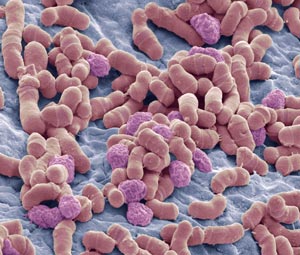
The genomes of all 14 species of the skin fungus Malassezia have been sequenced.
© Science Photo Library – STEVE GSCHMEISSNER/Brand X Pictures/Getty
The most common skin diseases, including dandruff and eczema, are associated with 14 species in one fungal genus, all of whose genomes have been sequenced by A*STAR researchers. The genomic analysis supports definitive, yet surprising, conclusions about the abundance of the yeast and its diversity and adaptation to life on human skin.
“Malassezia is the most dominant fungus on human skin so, regarding skin health, it is a key fungus to study,” says Niranjan Nagarajan at the A*STAR Genome Institute of Singapore, who led the international collaboration along with Thomas Dawson at the A*STAR Institute of Medical Biology.
Malassezia is the only genus in a class of more than 1,500 plant pathogens to have adapted to warm-blooded animal hosts, including dogs, cats and pigs. Animal skin, unlike carbohydrate-rich plants, is deficient in carbohydrate but offers a substantial array of lipids. Malassezia thrives on lipid-rich surfaces, colonizing the deep folds of the body from the elbow pit to the brow crease.
Despite their abundance and close association with many skin disorders, the genomes of only two species had been fully sequenced. Nagarajan’s group assembled 24 strains, representing all 14 known species in the genus, enabling a thorough analysis of their evolution and functional genes.
High-throughput genome sequencing confirmed that Malassezia strains have a short genome; only seven to 15 million base pairs, compared to three billion in humans. Analysis of skin samples from 18 sites on adults and children detected 12 of the 14 species in at least one individual. But, Nagarajan’s team found no matches in ocean, soil and mouth samples, challenging earlier reports of Malassezia-like organisms in these environments.
The researchers compared their genomic library against 16 closely related fungal genomes to identify genetic characteristics unique to Malassezia. As expected, the fungus had lost the ability to produce a large number of enzymes involved in digesting carbohydrates. More intriguing was that all 14 species lack the gene encoding the enzyme required to synthesize fatty acids. This loss suggested that Malassezia depends entirely on lipids — a hunch confirmed by the researchers when they were unable to grow strains of the fungus in lipid-free culture.
The comparative analysis also uncovered a few genes unique to Malassezia, including one gene family present in all 14 species. “To be so well conserved over a large evolutionary timescale is quite striking — they cannot survive without them,” says Nagarajan. He hopes that the research will prompt further studies comparing Malassezia living on healthy versus diseased skin to identify potential treatment targets.
The A*STAR-affiliated researchers contributing to this research are from the Genome Institute of Singapore, the Institute of Medical Biology and the Bioinformatics institute. For more information about the team’s research, please visit the Computational and Systems Biology webpage.




